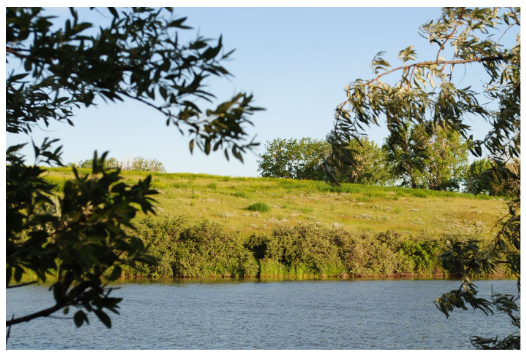The Wetland Atlas of Alberta, a comprehensive report on the ABMI’s 15+ years of wetland monitoring, has been newly updated.
What’s New in this Update
We’ve updated Section 3.1: Human Footprint Surrounding Wetland Health Monitoring Sites. Using the latest version of the Human Footprint Inventory (HFI), we summarized the per cent area of human footprint (circa 2021) in catchments surrounding the ABMI’s wetland health monitoring locations, and also reported the percentage change in human footprint from 2010 to 2021. In addition, we added new results summarizing the area of impervious surfaces within these catchments. Impervious surfaces—such as roads, parking lots, and buildings—prevent stormwater from seeping into the ground, altering natural water flow and drainage patterns within a catchment, which can have a number of impacts on wetlands.
Why Monitor Wetlands?
Wetlands are an integral part of Alberta’s landscape, covering over 20% of our province and providing numerous benefits such as water purification, drought mitigation, carbon storage, wildlife habitat, and human recreation. Our goal for the Wetland Atlas is to provide Alberta’s land managers and policymakers with a tool to help empower them to make informed decisions
about resource management and land use. The interactive and easy-to-navigate format means this is an accessible document that we hope is also useful for all Albertans who want to know more about our province’s wetland areas.
Human Footprint Analysis
In this report, we measure human footprint in catchments surrounding the ABMI’s shallow open water wetland sites that are monitored as part of our wetland health monitoring program. We used a combination of methods to delineate topographic catchment areas, including GIS tools, a digital evaluation model, simulated flow direction, and the ArcGIS watershed tool. We used the recently released Human Footprint Inventory for 2021 to update human footprint results, including a comparison with human footprint coverage in 2010. The ABMI defines human footprint as the temporary or permanent transformation of native ecosystems to support residential, recreational or industrial land uses. Visit the Open Data Portal to download our Human Footprint data, or view our Mapping Portal for an interactive look at human footprint coverage along with the distribution of wetlands in Alberta using ABMI’s Wetland Inventory.
Measuring the extent and types of human footprint in catchments around wetland sites provides insight into how landscape change nearby might impact wetlands themselves, such as roads disrupting water flow. While nearby human footprint represents a potential source of disturbance to wetlands, any impacts to wetlands themselves were not assessed in this report. Furthermore, this analysis does not capture or measure the loss of wetlands.
In Case You Missed It
Earlier this year, we added Section 3.3: Effects of Agriculture and Climate Change on Prairie Wetlands. This section covers a four-year project in which the ABMI has partnered with InnoTech Alberta and Ducks Unlimited Canada to better understand linkages between wetland health and waterfowl breeding success in the face of agricultural land use and climate change.
This project uses a broad range of methods to measure wetland health and waterfowl breeding productivity, including sampling water quality, studying the relative abundance of macroinvertebrates using genomics (genetics-based) methods, and detecting waterfowl predators using autonomous recording units and remote cameras.
Year 1 of the study focused on collecting and processing samples and developing protocols for extracting and sequencing invertebrate community DNA and eDNA to develop a DNA library to assist in future identification. Aquatic macroinvertebrates are a foundation of the biotic community in wetlands and can provide insight into overall wetland health. The aim for Year 2 is to refine techniques, expand data collection, and develop an optimized method to characterize aquatic macroinvertebrate and aquatic vegetation community composition and relative abundance. In Years 3 and 4, these optimized methods will be used across a larger sample of Alberta wetlands. Keep an eye out for future updates to this exciting project!
Explore the Atlas
The Wetland Atlas of Alberta is a living document and will be updated to reflect new and emerging information as it becomes available. Explore the full report online at wetland-report.abmi.ca.
This report was made possible with the support of the ABMI’s partners, including InnoTech Alberta, the University of Alberta, and the University of Calgary; Ducks Unlimited Canada; and funding supplied by the Government of Alberta.

